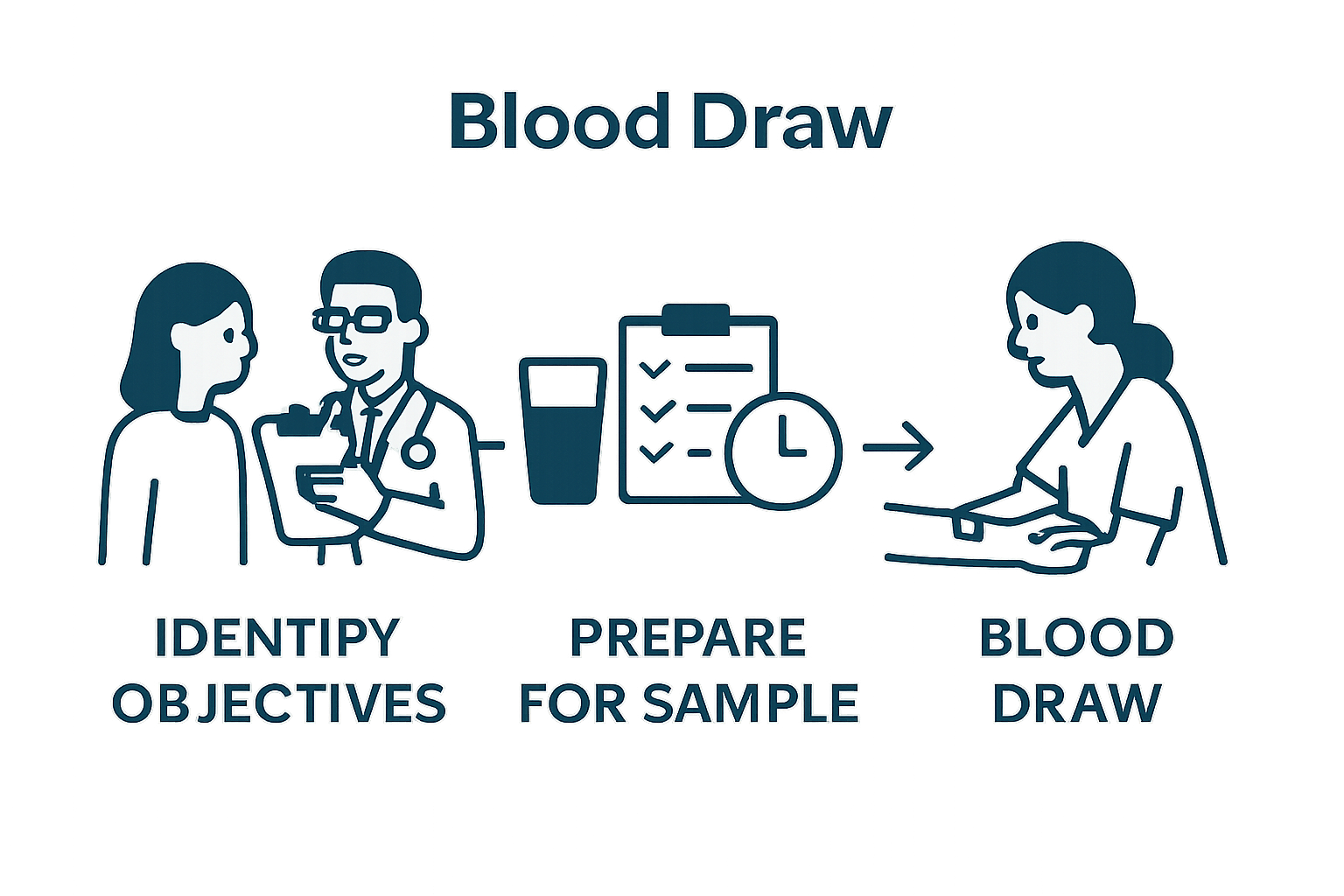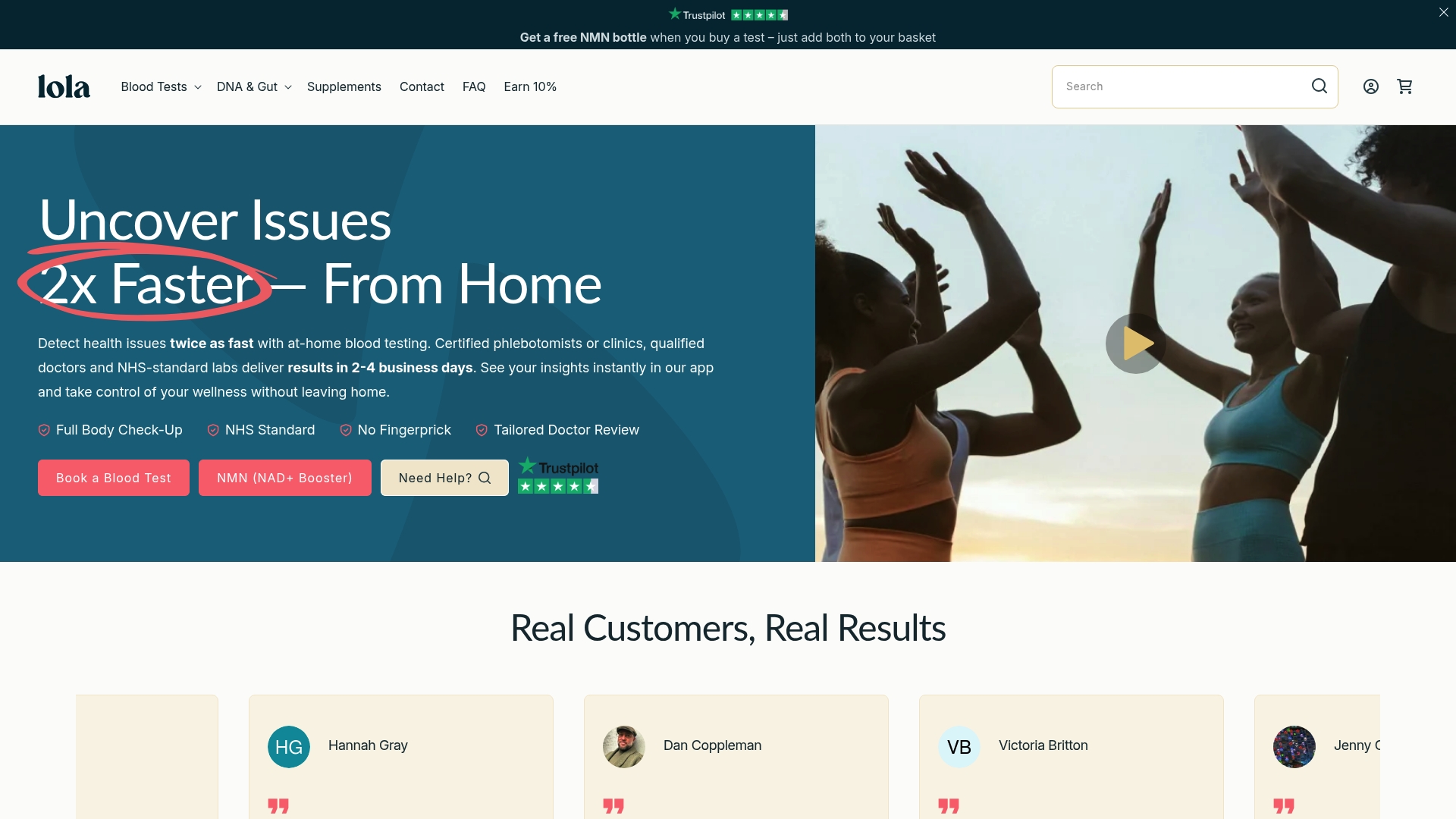Blood tests have become a cornerstone for women who want a clearer view of their health, and there is a reason for this focus. Comprehensive blood panels can reveal critical health insights that go far beyond basic screenings, offering up to 30 different measurements in a single test. You might assume the process is straightforward: book a test, give some blood, wait for results. That idea misses the powerful potential locked within each step. Because what truly sets blood testing apart is how a thoughtful workflow can transform raw data into personalised action, shaping your wellbeing in ways that surprise most people.
Table of Contents
- Step 1: Identify Your Health Objectives
- Step 2: Choose Appropriate Blood Tests
- Step 3: Prepare For Sample Collection
- Step 4: Conduct The Blood Test
- Step 5: Review And Interpret Results
- Step 6: Implement Necessary Health Changes
Quick Summary
| Key Point | Explanation |
|---|---|
| 1. Define personal health objectives | Assess your current health status and family history to tailor blood tests to your unique needs. |
| 2. Select appropriate blood tests | Work with a healthcare professional to determine which tests provide holistic insights into your health. |
| 3. Prepare for sample collection | Follow specific guidelines like fasting and hydration to ensure accurate test results. |
| 4. Review results with a professional | Interpret test outcomes and identify key indicators to understand your health better. |
| 5. Implement actionable health changes | Develop a structured plan based on test results to improve your overall wellbeing incrementally. |
Step 1: Identify Your Health Objectives
Optimising your blood testing workflow for women begins with a critical foundational step: clearly defining your personal health objectives. This initial phase is about understanding your unique health landscape and developing a strategic approach to monitoring and improving your wellbeing.
Starting your health journey requires a thoughtful assessment of your current physical condition, family medical history, and specific health concerns. Women often overlook the importance of personalised health tracking, but a targeted approach can reveal critical insights. Consider factors like age, lifestyle, genetic predispositions, and any existing symptoms or health conditions that might require closer monitoring.
To effectively identify your health objectives, begin by scheduling a comprehensive consultation with a healthcare professional who can help you map out your specific needs. During this consultation, discuss your family medical history, current health status, lifestyle factors, and any specific concerns you might have. A professional can help you pinpoint which biomarkers and health indicators are most relevant to your individual profile.
The Women’s Health Blood Tests Guide offers comprehensive insights into selecting the most appropriate tests for your unique health profile. By understanding which tests align with your objectives, you can create a targeted approach to health monitoring.
Key areas to consider when identifying your health objectives might include:
- Hormonal balance and reproductive health
- Metabolic function and potential risk factors
- Cardiovascular health indicators
- Immune system performance
- Nutritional and vitamin levels
Remember that your health objectives are not static. They will evolve with age, lifestyle changes, and emerging health insights. Regular reassessment ensures that your blood testing workflow remains precise, relevant, and aligned with your current health needs. By taking a proactive and personalised approach, you transform blood testing from a routine medical procedure into a powerful tool for understanding and optimising your overall wellbeing.

Step 2: Choose Appropriate Blood Tests
Choosing the right blood tests is a pivotal moment in your health monitoring journey, transforming generic screening into a personalised health strategy. This step requires careful consideration of your individual health profile, risk factors, and specific wellness objectives identified in the previous stage.
Navigating the landscape of blood testing options can feel overwhelming, but a systematic approach simplifies the process. Start by consulting with a healthcare professional who can provide expert guidance tailored to your unique needs. They will help you understand which biomarkers are most relevant to your current health status and potential future risks.
Comprehensive panels are key to obtaining a holistic view of your health. These panels typically examine multiple indicators across different bodily systems, providing insights far beyond basic screenings.
Consider tests that evaluate hormonal balance, metabolic function, cardiovascular health, immune system performance, and nutritional status. Each of these areas contributes critical information about your overall wellbeing.Understanding the Role of Blood Tests in Women’s Health offers deeper insights into selecting the most appropriate tests for women at different life stages. Your age, lifestyle, family history, and specific health concerns will influence the most suitable testing approach.
Key considerations when selecting blood tests include:
- Your current age and life stage
- Specific health concerns or symptoms
- Family medical history
- Lifestyle factors like diet, exercise, and stress levels
- Existing medical conditions
Remember that blood testing is not a one-time event but an ongoing process of health monitoring. As your body changes and new health insights emerge, your testing strategy should evolve. Regular consultations with healthcare professionals will help you refine and update your approach, ensuring that your blood testing workflow remains precise, relevant, and proactive in supporting your long-term health and wellness goals.
Step 3: Prepare for Sample Collection
Preparing for blood sample collection is a critical step that directly impacts the accuracy and reliability of your test results. This phase is about creating optimal conditions for precise medical diagnostics, ensuring that every aspect of your sample collection process is carefully managed.
Proper preparation begins well before you arrive for your blood test. Your body’s current physiological state can significantly influence test outcomes, making preparation a nuanced and important process. Most blood tests require specific pre-test conditions, such as fasting for 8 to 12 hours before the collection. This means avoiding food and drinks except water, which helps ensure accurate measurements of glucose, cholesterol, and other metabolic markers.
Medication and supplement intake also require careful consideration. Some medications and supplements can interfere with test results, so it is crucial to discuss your current regimen with healthcare professionals. They may advise temporary adjustments or specific guidance on when and how to take your regular medications in relation to the blood test.
How to Prepare for Phlebotomy provides comprehensive guidance on getting ready for your blood draw. Staying hydrated is particularly important, as good hydration makes veins more accessible and can make the blood draw process smoother and more comfortable.
Key preparation steps include:
- Confirming fasting requirements with your healthcare provider
- Drinking plenty of water in the 24 hours before your test
- Wearing comfortable clothing with easily accessible arms
- Bringing a list of current medications and supplements
- Getting adequate sleep the night before
On the day of your blood test, arrive with a calm and relaxed mindset. Stress and anxiety can temporarily affect certain biomarkers, so deep breathing or light meditation before your appointment can be beneficial. By meticulously following preparation guidelines, you maximize the potential for obtaining accurate, actionable insights into your health, transforming a simple blood draw into a powerful tool for understanding your body’s intricate systems.
Below is a checklist to help you prepare thoroughly for your blood sample collection appointment and maximise the accuracy of your results.
| Preparation Step | Purpose | Notes |
|---|---|---|
| Confirm fasting requirements | Ensures metabolic markers are accurately measured | Check with your healthcare provider in advance |
| Drink plenty of water | Makes veins more accessible for easier collection | Stay hydrated during the 24 hours prior |
| Wear comfortable clothing | Eases access to your arm for sample collection | Choose tops with loose or short sleeves |
| Bring medication/supplement list | Allows accurate assessment and avoids test interference | List all current prescriptions and supplements |
| Get adequate sleep | Supports accurate measurement of certain biomarkers | Aim for regular restful sleep the night before |
| Arrive relaxed and calm | Reduces anxiety and stabilises physiological readings | Try deep breathing or meditation before your visit |

Step 4: Conduct the Blood Test
Conducting your blood test represents a pivotal moment in your health monitoring journey, transforming preparatory steps into actionable medical insights. This stage is about ensuring a smooth, professional, and precise sample collection process that maximises the potential for accurate diagnostic information.
Upon arriving at your chosen testing location, whether a clinical setting or home collection service, maintain a calm and relaxed demeanor. Anxiety can subtly influence physiological markers, potentially affecting test results. Professional phlebotomists are trained to make the experience as comfortable and efficient as possible, using techniques that minimise discomfort and maximise sample quality.
The actual blood draw typically takes mere minutes but requires careful attention to protocol. A trained healthcare professional will carefully select an appropriate vein, usually in the inner elbow or forearm, where blood vessels are most accessible. They will clean the area with an antiseptic wipe to prevent any potential infection, then apply a tourniquet to make veins more prominent. The needle insertion is quick, and while you might feel a slight pinch, the process is generally brief and manageable.
Why Book a Clinic Blood Test provides additional context about the benefits of professional blood testing environments. During the collection, communicate openly with your phlebotomist about any concerns or previous experiences that might impact the procedure.
Key moments to focus on during blood collection include:
- Remaining still during the needle insertion
- Breathing normally and staying relaxed
- Informing the professional immediately if you feel lightheaded
- Allowing the professional to guide you through each step
- Maintaining clear communication about your comfort level
After the blood draw, the professional will apply a small bandage and provide brief post-collection instructions. You might be advised to keep the bandage on for a few hours and avoid strenuous activity. Some individuals experience mild bruising or tenderness at the collection site, which is normal and typically resolves quickly. By approaching this step with preparation and a positive mindset, you transform a routine medical procedure into a proactive step towards comprehensive health understanding.
Step 5: Review and Interpret Results
Reviewing and interpreting your blood test results marks a crucial transition from raw data to actionable health insights. This step transforms complex medical information into a clear roadmap for understanding your current health status and potential future interventions.
Comprehensive result interpretation requires more than simply glancing at numbers. Professional medical guidance is essential in contextualising your results, understanding their broader implications, and distinguishing between normal variations and potential health signals.
Most modern healthcare platforms provide digital portals where results are presented with reference ranges, making initial navigation more accessible.Schedule a consultation with your healthcare provider to walk through the results comprehensively. This discussion should cover not just the numerical values, but their potential meanings, interrelationships, and any recommended follow-up actions. Some biomarkers might appear slightly outside standard ranges, which doesn’t necessarily indicate a serious health issue but could suggest areas warranting closer monitoring or lifestyle adjustments.
Understanding the Role of Blood Tests in Women’s Health offers additional context for interpreting complex test results. Pay special attention to trends and patterns rather than isolated measurements, as health is a dynamic, interconnected system.
Key considerations during result review include:
- Comparing current results with previous tests
- Understanding the context of each biomarker
- Identifying any significant deviations from normal ranges
- Discussing potential lifestyle or dietary interventions
- Planning any necessary follow-up tests or specialist consultations
Remember that blood test results are a snapshot of your health at a specific moment. They provide valuable insights but should be interpreted holistically, considering your overall lifestyle, family history, and current health objectives. A proactive approach involves not just understanding the results, but developing a personalised strategy for ongoing health optimization.
By treating these results as a collaborative conversation between you and your healthcare provider, you transform medical data into a powerful tool for long-term wellness and preventative care.
Step 6: Implement Necessary Health Changes
Implementing health changes represents the most critical stage of your blood testing workflow, transforming insights into tangible actions that can significantly improve your overall wellbeing. This step is about creating a strategic, sustainable approach to addressing the specific health indicators revealed through your comprehensive blood testing process.
Translating medical data into practical lifestyle modifications requires a nuanced and personalised strategy. Your healthcare provider will likely recommend targeted interventions based on your specific test results. These recommendations might encompass dietary adjustments, exercise modifications, stress management techniques, or potential supplementation to address specific nutritional or metabolic gaps identified in your blood work.
Consider developing a structured implementation plan that breaks down broader health recommendations into achievable, incremental steps. This approach prevents overwhelm and increases the likelihood of sustainable change. For instance, if your results indicate potential vitamin deficiencies, work with a nutritionist to design a meal plan that naturally incorporates missing nutrients rather than relying solely on supplements.
8 Key Items for Your Health Screening Checklist provides additional guidance on maintaining a holistic approach to health management. Regular follow-up and monitoring are crucial to understanding the effectiveness of your implemented changes.
Key strategies for successful health change implementation include:
- Creating a detailed, time-bound action plan
- Setting realistic and measurable health goals
- Tracking progress through periodic reassessments
- Building support systems with healthcare professionals
- Maintaining flexibility and adaptability in your approach
Remember that health optimization is an ongoing journey, not a destination. Your initial blood test results provide a snapshot of your current health, but consistent monitoring, lifestyle adjustments, and proactive management will determine long-term wellness. By approaching these changes with patience, commitment, and a data-driven mindset, you transform medical insights into a comprehensive strategy for improved health and vitality.
The following table provides an overview of the main steps in the optimised blood testing workflow for women, along with their objectives and expected outcomes.
| Step | Objective | Key Outcome |
|---|---|---|
| Identify health objectives | Tailor the process to your personal health needs | Defined priorities for testing |
| Choose appropriate blood tests | Select tests that reflect your profile and concerns | Relevant, personalised blood panel |
| Prepare for sample collection | Ensure accuracy and reliability of your blood results | Optimal test conditions |
| Conduct the blood test | Obtain high-quality samples in a professional manner | Usable, reliable blood samples |
| Review and interpret results | Turn complex data into actionable health insights | Understood results and guidance from experts |
| Implement necessary health changes | Translate insights into concrete, sustainable actions | Health improvements and ongoing optimisation |
| Celebrate small victories, remain consistent, and view each modification as an investment in your future wellbeing. |
Upgrade Your Blood Testing Journey with Lola Health
After reading how essential it is to define health objectives and streamline your blood testing workflow, you may be feeling the weight of managing complex health data, securing fast results, and finding tests that reflect your unique biology. Women seeking more control over their wellbeing in 2025 deserve a service that transforms knowledge into effective action. Lola Health bridges these needs by offering tailored, at-home or clinic-based blood testing solutions, all led by certified nurses and trusted UK laboratories.

Why wait to optimise your monitoring? Discover our most trusted Best Sellers, select from comprehensive wellness panels, and track up to 70 biomarkers from the comfort of home or by booking a professional nurse visit. Your secure results and expert doctor reviews are just days away, helping you confidently implement positive changes. Visit Lola Health Online now to order your personalised test kit and take control of your health journey today.
Frequently Asked Questions
How can I identify my health objectives for blood testing?
Starting your health journey involves assessing your current physical condition, family medical history, and specific health concerns. Consulting a healthcare professional can help you define your unique health objectives and determine which biomarkers need monitoring.
What should I consider when choosing blood tests?
When selecting blood tests, consider your age, current health status, family medical history, lifestyle factors like diet and exercise, and any specific symptoms or health concerns. Comprehensive panels that assess multiple indicators provide a holistic view of your health.
How can I prepare for my blood sample collection?
Preparation for blood sample collection includes confirming fasting requirements, staying hydrated, wearing suitable clothing, and discussing your current medications with your healthcare provider. Arrive relaxed on the day of your test to help minimise anxiety during the procedure.
What should I do after reviewing my blood test results?
After reviewing your results, schedule a consultation with your healthcare provider to interpret the data comprehensively. Identify any significant deviations from normal ranges and establish a personalised strategy to implement necessary health changes based on your bloodwork.


